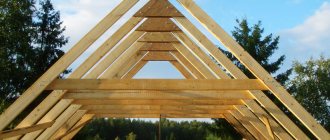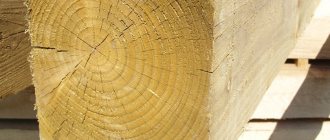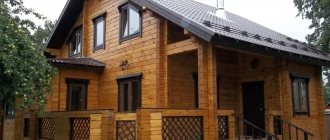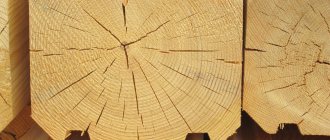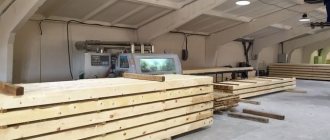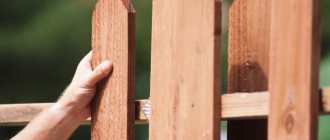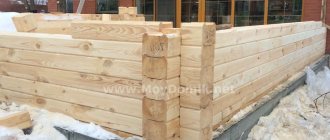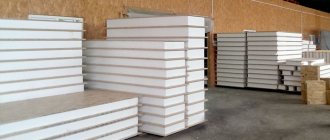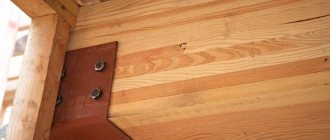Lumber is widely used in the construction of residential and industrial buildings. Wood is a durable, reliable, safe material. New technologies and processing methods ensure a long service life of wooden products. In the construction of buildings, they are used in the construction of foundations, partitions, ceilings, stairs, doors, and window frames. Lumber is the main raw material for making furniture.
In this article you will learn:
- Definition of the term "lumber".
- Varieties.
- Edged board.
- Wooden beam.
- Wooden block.
Definition of the term "lumber"
Lumber is a log sawn longitudinally, having specified shapes and dimensions, and having the following properties:
- moisture resistance;
- strength;
- good machinability;
- low thermal conductivity;
- no toxic emissions.
These qualities determine the scope of application of a particular type of lumber. The properties of the material depend on the type of wood used.
Varieties
The construction market offers a significant range of wood materials.
Kinds:
- plates;
- boards;
- lagging;
- bars;
- sleepers;
- croaker;
- bars.
The greatest demand in the construction market is for edged boards, timber and lumber.
Load-bearing walls and interfloor ceilings
Durable wall structures of a residential building are the main indicator of the entire structure. To build strong walls, it is important to take into account fundamental factors. First of all, look at the technical indicators of the lumber - the section of the profiled timber and its size range. For our climate, the solution would be profiled timber 200x200 millimeters.
Let us examine in detail the technical aspects that confirm the rationality of this choice.
- These parameters guarantee the strength and reliability of the walls. Load-bearing structures made from such timber will provide the structure with stability, as well as the ability to withstand maximum load.
- Glued lumber with a cross-section of 200x200 has high thermal insulation, which is similar to a brick structure with a wall thickness of approximately 90 centimeters, that is, the timber does not need additional insulation.
- This building material perfectly protects against moisture, which prevents the appearance of fungus/mold.
Profiled timber with large dimensions is suitable for organizing a finished floor in a timber house. This cross-section of timber is also used for flooring between tiers in multi-story buildings. The high degree of reliability of the lumber allows it to withstand significant loads, and thanks to the built-in profile, an almost solid surface is obtained.
Significantly sized timber is an ideal solution for arranging fastening points. The joining of timber elements is carried out using special locks; if you use thick lumber, the elements turn out to be massive and reliable.
Important! When carrying out construction work, remember that some components do not require strength, but lightness and aesthetics.
Edged board
An edged board is obtained from a log, having processed it on all sides. The product does not have edges covered with bark. The board is cut from a single log. Its edges are located strictly at right angles to each other. This is a condition for the exact fit of the boards to each other. The main types of wood for the production of edged boards are coniferous species. For interior decoration, valuable types of wood are preferable.
The dimensions of the building material are important for the consumer. These indicators are established by GOST.
Standard sizes offered by manufacturers:
- length – 3000, 4000, 6000 mm;
- width – from 75 to 275 mm in increments of 25 mm;
- thickness – 16, 19, 22, 25, 32, 40, 44, 50, 60, 75 mm.
The length of the edged board is measured as the minimum distance between the ends. Width and thickness are measured at any point, departing from the ends by more than 150 mm. There are edged boards of non-standard dimensions on sale.
Information about the product can be gleaned from the tag on the package. The material (board), grade, type of wood, dimensions, GOST are indicated there.
Dimensions, GOST section
The length of wooden beams (beams) range from three to nine meters, but the main lengths are considered to be 300 - 600 cm. As the most optimal dimensions for transportation, storage and construction. In some cases, timber can be made to individual sizes (up to 9 m). This mainly applies to standard typical structures made of profiled timber.
The cross-sectional dimensions of wooden beams start from 100 mm (10 cm) and reach 300 mm. With a square cross-section it is:
- 100 X 100 mm;
- 150 X 150 mm;
- 200 X 200 mm;
- 300 X 300 mm.
- 100 X 150 mm;
- 150 X 200 mm;
- 250 X 300 mm;
- Or a different size (100 X 200 mm, etc.).
Standard sizes of wooden beams according to state standards (GOST) are mandatory for all enterprises producing such products and are indicated in the following table:
- GOST 8486-86 “Softwood lumber”;
- GOST 2695-83 “Hardwood lumber”;
- GOST 23431-79 “Wood. Structure and physical and mechanical properties. Terms and Definitions";
- GOST 18288-87 “Sawmill production. Terms and Definitions";
- GOST 24454-80 “Softwood lumber. Dimensions".
In addition to the size of wooden beams according to GOST, there are a number of tables with standards for its grade, humidity, properties, and so on.
Wooden beam
This lumber has a rectangular or square cross-section, a thickness of at least 100 mm, and a considerable length. Almost all load-bearing and enclosing elements in private construction are made of timber.
Type of material depending on side processing:
- double-edged, two opposite sides are cleaned, the rest are left rounded;
- in the three-edged one, three surfaces are cleaned;
- in a four-room beam, all the edges are flat.
The beam can be made from solid wood or glued together from separate parts - lamellas.
The standard length of the timber is 6000 mm; upon request, we can produce material with a length from 2000 to 9000 mm. The length of laminated veneer lumber reaches 18,000 mm. The thickness of the timber varies from 100 to 250 mm in increments of 25 mm. The beam has a width from 100 to 275 mm. At the customer's request, timber of other sizes can be manufactured. A product with a cross-sectional shape of 50 x 50 mm is called half-timber. The most popular material is with a cross section of 150 mm. A house built from which timber retains heat well and does not create excessive load on the foundation.
Timber price
The price of a wooden beam depends on its type and size. Thus, a cube of laminated larch building material with a cross-section of 20 by 20 centimeters and a length of 6 meters costs approximately 27 thousand rubles per cubic meter. For a beam of the same size, but edged from solid pine, they ask about 7 thousand rubles. This is the price of a first-class product. You can buy a second-class one for 5 thousand rubles per cubic meter.
The price of timber partly depends on the season. Construction costs skyrocket. There is also a relationship between the cost of the product and the region of sale. Cheaper is wood that grows and is harvested within the region, republic or region.
Once a budget material, wood is moving into the elite category. Deforestation leads to material shortages. If we take into account the costs of insulation, a house made of average quality timber is more expensive than a similar building made of aerated concrete or other types of foam blocks.
Wood block
A bar is a smaller version of a beam. These small logs, sawn and finished on all sides, are a popular building material. The section can be in the shape of a square, rectangle, or figured profile. There are edged and planed timber. Planed bars have a maximum variation in parameters, reaching up to 25%. Curvature and poorly processed edges are also possible. This explains the low cost of the material. The bars are used in the construction of supporting structures, floors, stairs, railings, window sills, bathhouses, sandboxes, and gazebos. The finished product must be processed to impart the necessary decorative and protective properties to its surface.
The length of the bars ranges from 3000 mm to 6000 mm. The difference between a beam and a block is in size; a block can be less than 100 mm thick. According to standards, its width can exceed its thickness by no more than 2 times. The width and thickness of hardwood timber is 19.22, 25, 32, 40, 45, 50, 60, 70, 80, 90 and 100 mm.
Knowing the dimensions of building materials allows you to accurately calculate the volume of purchases.
You need different timber, you need a lot of it
This is not enough to build a house.
Timber in construction has a division that you pay little attention to in everyday life; indeed, timber is a material with a square section and a considerable length.
And there are several of them:
- Traditional beams are exactly those same beams with a section of 100x100 mm or 150x150 mm. Quite popular products are used to cover ceiling structures, can be used independently in the construction of sheds, garages and various buildings, and participate in the formation of floors. The standard length of the timber in this case will be 6 m;
For your information! Sometimes in the literature you can find information about the so-called rounded timber. This is a somewhat misleading name, since, in essence, timber is the process of sawing logs. There is no such technological process when timber is obtained from a log and turned into a log again, this is absurd. And there is a process for processing wooden trunks, as a result of which a rounded log without bark, of a single diameter, has a discharge groove and is ready for construction.
- Profiled timber is the most interesting material, since as a result of processing, not only the edges are trimmed to a square section, but combinations are possible when one side is semicircular and is actually the slab of the log, the other is flat. The upper and lower edges of such a product will have special grooves that allow you to assemble a house or any other structure using classical technology, but much faster. The standard dimensions of wooden beams are 6 m long, and the cross-section can be of several types from 135x280 to 270x240 mm. Intermediate options are also possible;
But these products are much more interesting. Photo of profiled timber.
Interesting to know! As you have already noticed, the length of a standard beam is 6 m, but this absolutely does not mean that manufacturers will not be able to make longer beams. Everything is done only to order, and the price of such a product will be higher.
- There is another development that allows us to expand the capabilities of wood and its use in construction. It's called laminated veneer lumber.
This is the product that is in greatest demand right now:
- firstly, it is the same profiled timber, but consisting of pieces, which significantly increases its capabilities;
- secondly, due to the lamination, the price of such a product will be lower than its solid wood counterpart.
For comparison, the standard dimensions of laminated veneer lumber (for example, from larch) are not only 6, but also 12 m, which allows you to build a solid wall without extensions and additional seams through which cold and wind can seep in (even theoretically). According to the conventional cross-section, these products completely replicate ordinary profiled timber.
And although the traditional types of wood for construction are pine and spruce, cedar is also often used as a VIP variety; larch has proven itself well.
Useful tips - smart use
Glued analogues may be more interesting.
Helpful advice may or may not be followed.
However, in any case, it’s still worth listening to them, especially since they are to the point, so:
- Products made from coniferous trees are often used for the construction of external walls and floor beams, and floor lathing. For interior finishing work, more expensive and richer in terms of pattern and color saturation, products made from hardwood (linden, oak, ash, beech) are used;
- When choosing beams, pay special attention to the method of storage, packaging and appearance of the products. Remember that when the humidity of wood increases to 30%, its strength decreases by 1.5 times, which in turn can lead to deformation of the beam during drying, as well as other defects;
- If you choose profiled timber or laminated veneer lumber, then after inspecting the condition of the wood, pay attention to the condition of the grooves; they should be smooth, without gross damage. The whole point here is that the very design of this lock prevents moisture from entering the space between the timbers, and, consequently, rotting of the wood. The presence of damage may provide such an opportunity;
Don’t rush to install windows and doors right away, the house will shrink.
Note! Glued laminated timber looks somewhat more preferable than its solid relative. And the declared standard size of the timber is impressive, and the price offered by sellers is low. Some craftsmen will even tell you that such timber, or rather a house made from it, does not shrink. And there is shrinkage, small, but there. Therefore, no matter how much you would like to immediately begin installing windows and doors, interior decoration, remember that such buildings can shrink by several centimeters, which is not as noticeable as when installing a log frame, but, nevertheless, deform the window frames or doorways can.
- Any instruction will tell you that wood is a sponge that can absorb moisture, so if you brought timber and logs and do not plan to immediately start building a house, it is better to cover the material. The film is quite suitable for this. This is especially important if the material is released for sale under-dried.



